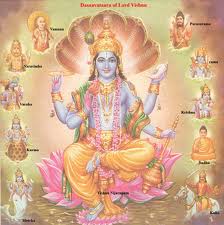| 2 Preface to Puranas | |
In ‘Hindu Sampradaaya’, the very first thought goes to Vedas and Puranas.When one thinks of Puranas, the mind-set gets invariably tuned to Naimisharanya and Suta Maha Muni. Even a child witnessing or participating in a Vrata like Ganesh Chaturthi or Saynanarayana Puja would have surely heard of Naimisharanya. This Forest had become a Symbol of Hindu Dharma for the reason that while Dwara Yuga was almost over and Kali Yuga was being entered into, Brahma released the Kala Chakra called Manonmaya Chakra or Maya to assess the impact of its Entry from one Yuga into another. This Chakra (disc /wheel) appeared to have travelled round the entire Universe and finally got broken as the prescribed circumference of the Chakra viz the ‘Nemi’ fell short of the measure and Brahma felt that that was a ‘Safety Zone’where he could take up ‘Panah Srishti’ and also devote that Extremly Hallowed Land for the use of Yagnas and other Sacred Activities; this was the Place where Veda Vyasa was famed to have executed the division of Vedas and scripted Puranas and this was also the Place where Suta Maha Muni disseminated knowledge of Puranas, Vedangas and various other Scriptures.This large segment of Land called the Naimisharanya still exists till date some 80 km away from Lucknow in Uttar Pradesh, leaving vestiges of the Past of some 5000 years at the cross point of the Yugas. There is a Chakra Tirtha even now where lakhs of Rishis were stated to have bathed and performed Yagnas. This Tirtha is supposed to be fathomless where a huge Hanuman Idol of 18feet-believed to be self-manifested-is in position; the local fables reveal that Rama and Lakshmana were rescued from Patala by Hanuman where the latter were hidden by Ravana and came up from Chakra Tirtha; the Britishers wished to disprove this belief that Chakra Tirtha was fathomless and sent a cable of 1000 meters (30,000 ft depth) and gave up the experiment! Till date, there is a Vyasa Gaddi (Seat) under a Banyan tree; a Shiva Temple where Shiva Linga’s eyes look east in the morning and gradually look west at the Sunset and a Lalitha Devi’s Temple of reputation. Even now, Yagnas and Homas are conducted at Naimisha and thousands take bath on Full Moon days, Solar/ Lunar Ecilpses etc. | |
 Prev:Introduction Prev:Introduction | |

 Next:Introduction
Next:Introduction